|
The Culebra National Wildlife Refuge is one of over 400 wildlife refuges administered by the U.S. Fish and Wildlife Service in the United States, Puerto Rico
and U.S. Territories. These refuges, managed principally for migratory birds and other unique wildlife conditions, are part
of the National Wildlife Refuge System in the Department of the Interior. The Culebra Refuge, which comprises about 1,480 acres, includes 23 islands and rocks in addition
to the four tracts on the main island of Culebra. The refuge is well known as a nesting site for a variety of seabirds and
preserves important habitat for endangered sea turtles.
The mean temperature for Culebra is
about 80°F (27°C). A relatively dry period occurs from January to March/April. The heaviest rains generally are recorded
from August to November. The average annual rainfall is approximately 25–30 inches.
The Culebra National Wildlife Refuge was established on February 27, 1909 by Theodore Roosevelt,
making it one of the oldest refuges in the system. Early ornithologists described the birds in and around the Culebra Archipelago,
but it wasn't until 1971 that new surveys revealed the wide variety of nesting seabirds and their numbers. The offshore islands, with the exception of Cayo Norte, totaling
702 acres, came under the administration of the Fish and Wildlife Service in 1975 when the Navy left Culebra. In 1982 an additional
776 acres of unique wildlife habitat were transferred from the Navy into the Culebra National Wildlife Refuge.
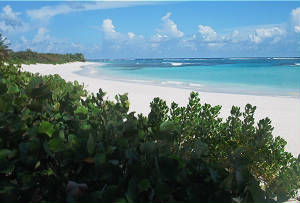
FLAMENCO PENINSULA
Flamenco Peninsula is an important site for sooty terns.
The population had once been estimated at as many as 160,000 birds, although this population declined significantly during
the late 1970's. Some causes for this decline are brush encroachment on the preferred breeding area of dense guinea grass,
over-grazing, and predation by rats and feral cats introduced into the area.
MOUNT RESACA
The
Mount Resaca Unit of the refuge insures preservation of one of the few remaining large blocks of dry subtropical forest on
Culebra. Large boulder-covered areas produce the park-like forest of Cupey and
Jaguey with their impressive stilt roots. The boulders support beautiful orchids, bromeliads and the endemic
peperomia. It is believed that the endangered Culebra giant anole lizard— not sighted for many decades— still survives in these forests. Other vegetative
zones, including the thick natural thorn thickets, palm forest types and cactus scrub clusters, support diverse numbers of
bird and reptile species.
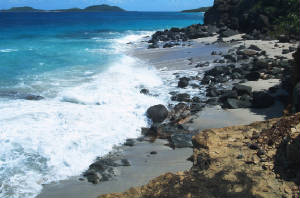
THE CAYS
The cays
surrounding Culebra support impressive numbers of breeding seabirds. From May to September nesting colonies of laughing gulls, bridled terns, sooty
terns, brown noddys and roseate
terns can be found. Several cays also support royal and sandwich tern colonies which have been reported to be on the decline in the Caribbean in recent years. Small
colonies of white-tailed tropic birds, red-billed
tropic birds, masked boobys, and red-footed
boobys are found here, as well as a thriving brown booby colony. Seabird
breeding activity can be found going on throughout the year.
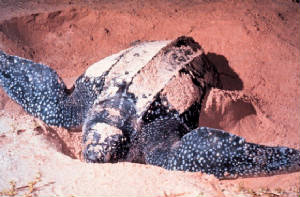
Culebrita and Cayo Luis
Peña are the larger and more diverse islands. This diversity includes beach areas, extensive forests, lagoons and rocky
precipices. As a result, a wider range of wildlife is present, including many
passerine bird species, waterfowl and reptiles. The beaches of Culebrita are included as critical habitat
for the endangered hawksbill turtle, as are most beaches of the northern shore
of Culebra. Three other endangered turtles species— the Atlantic green, the leatherback (shown here, digging
her nest), and the Atlantic loggerhead— may also be observed there. Extensive reef systems
and grass flats in Culebra's waters are critical as development and foraging habitat for these turtles.
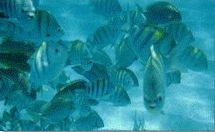
Coral reefs of the area are some of
the most spectacular of the entire Caribbean region. These thriving reefs represent some of the best living healthy reef ecosystems
of Puerto Rico due to the relative lack of development of the islands. The life cycles of many fish, amphibians, crustaceans
and a wealth of other marine organisms are directly tied to the coral reef ecosystems.
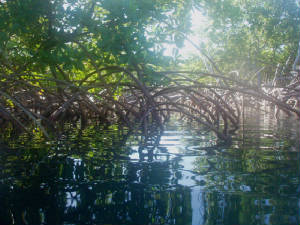
THE MANGROVES
The
mangrove units of the refuge form a unique habitat which is vital for coastal wildlife. Here the protein-rich waters provide
ample food sources for crustaceans and small fish, and, in turn, these food sources attract larger predatory fish as the food
chain continues. These mangroves form bountiful nurseries for marine life. Multitudes of fish and crustaceans arrive after
spawning to mature in these protected waters. Bird
life also abounds as the large fisheries attract numerous marine feeders. The mangroves surrounding Puerto del Manglar are
a favorite roosting site for the endangered brown pelican. These mangroves also protect this bay's phosphorescent qualities
by serving as a filter and buffer from sediments carried by runoff from the surrounding sloping terrain.
MANAGEMENT PROGRAM Active wildlife management efforts on the Culebra National
Wildlife Refuge concentrate on maintaining and re-creating the wide range of nesting habitats needed for colonial seabirds.
Unique wildlife habitats such as the Mt. Resaca Unit and the mangrove areas will be maintained in their natural conditions.
Human entry into the nesting colonies will be restricted in order to prevent disturbance to sensitive species who cannot tolerate
human intrusion. Development of the existing Mt. Resaca trail, and trails on Cayo Luis Peña and Isla Culebrita may
be planned for the refuge in the future.
VISITOR INFORMATION
The Mt. Resaca trail, Cayo Luis Peña and lsla Culebrita are all open daily from sunrise to
sunset. Special Use Permits, signed by the refuge manager, are required for entry to other units of the Culebra Refuge. These
permits and other information are available from the Refuge Manager at Lower Camp, Culebra.
• Flamenco
Peninsula and several of the cays and reefs were sites of intensive bombardment by the military. Many unexploded bombs are
present throughout these areas and could explode at any time. Do not touch, approach or disturb any ordnance seen. Visitors
must stay on existing roads and trails.
• Visitors entering the water from the refuge beaches do so
at their own risk. There are many rocks, coral reefs and marine organisms which could cause injuries and visitors need to
be careful in the water. Public-use regulations apply to the lands administered by Culebra National Wildlife Refuge in order
to insure protection of the rich and diverse resources.
• All plant material, both living and dead,
is protected.
For information
on the Refuge write to
Refuge Manager, General Delivery — Lower Camp, Culebra, PR 00645
Source: Publications of the U.S. Fish
and Wildlife Service
Culebra National Wildlife Refuge,
RF-41522-1- May 1988, Caribbean
Islands National Wildlife Refuge, August 1997
|



